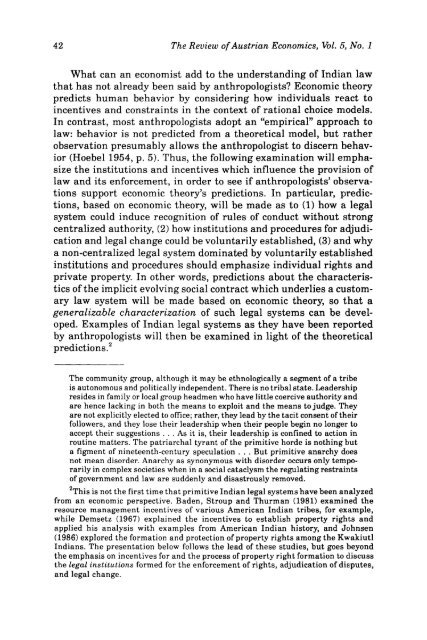Review of Austrian Economics - The Ludwig von Mises Institute
Review of Austrian Economics - The Ludwig von Mises Institute
Review of Austrian Economics - The Ludwig von Mises Institute
You also want an ePaper? Increase the reach of your titles
YUMPU automatically turns print PDFs into web optimized ePapers that Google loves.
42 <strong>The</strong> <strong>Review</strong> <strong>of</strong> <strong>Austrian</strong> <strong>Economics</strong>, Vol. 5, No. 1<br />
What can an economist add to the understanding <strong>of</strong> Indian law<br />
that has not already been said by anthropologists? Economic theory<br />
predicts human behavior by considering how individuals react to<br />
incentives and constraints in the context <strong>of</strong> rational choice models.<br />
In contrast, most anthropologists adopt an "empirical" approach to<br />
law: behavior is not predicted from a theoretical model, but rather<br />
observation presumably allows the anthropologist to discern behavior<br />
(Hoebel 1954, p. 5). Thus, the following examination will emphasize<br />
the institutions and incentives which influence the provision <strong>of</strong><br />
law and its enforcement, in order to see if anthropologists' observations<br />
support economic theory's predictions. In particular, predictions,<br />
based on economic theory, will be made as to (1) how a legal<br />
system could induce recognition <strong>of</strong> rules <strong>of</strong> conduct without strong<br />
centralized authority, (2) how institutions and procedures for adjudication<br />
and legal change could be voluntarily established, (3) and why<br />
a non-centralized legal system dominated by voluntarily established<br />
institutions and procedures should emphasize individual rights and<br />
private property. In other words, predictions about the characteristics<br />
<strong>of</strong> the implicit evolving social contract which underlies a customary<br />
law system will be made based on economic theory, so that a<br />
generalizable characterization <strong>of</strong> such legal systems can be developed.<br />
Examples <strong>of</strong> Indian legal systems as they have been reported<br />
by anthropologists will then be examined in light <strong>of</strong> the theoretical<br />
predictions. 2<br />
<strong>The</strong> community group, although it may be ethnologically a segment <strong>of</strong> a tribe<br />
is autonomous and politically independent. <strong>The</strong>re is no tribal state. Leadership<br />
resides in family or local group headmen who have little coercive authority and<br />
are hence lacking in both the means to exploit and the means to judge. <strong>The</strong>y<br />
are not explicitly elected to <strong>of</strong>fice; rather, they lead by the tacit consent <strong>of</strong> their<br />
followers, and they lose their leadership when their people begin no longer to<br />
accept their suggestions ... As it is, their leadership is confined to action in<br />
routine matters. <strong>The</strong> patriarchal tyrant <strong>of</strong> the primitive horde is nothing but<br />
a figment <strong>of</strong> nineteenth-century speculation . . . But primitive anarchy does<br />
not mean disorder. Anarchy as synonymous with disorder occurs only temporarily<br />
in complex societies when in a social cataclysm the regulating restraints<br />
<strong>of</strong> government and law are suddenly and disastrously removed.<br />
2 This is not the first time that primitive Indian legal systems have been analyzed<br />
from an economic perspective. Baden, Stroup and Thurman (1981) examined the<br />
resource management incentives <strong>of</strong> various American Indian tribes, for example,<br />
while Demsetz (1967) explained the incentives to establish property rights and<br />
applied his analysis with examples from American Indian history, and Johnsen<br />
(1986) explored the formation and protection <strong>of</strong> property rights among the Kwakiutl<br />
Indians. <strong>The</strong> presentation below follows the lead <strong>of</strong> these studies, but goes beyond<br />
the emphasis on incentives for and the process <strong>of</strong> property right formation to discuss<br />
the legal institutions formed for the enforcement <strong>of</strong> rights, adjudication <strong>of</strong> disputes,<br />
and legal change.

















